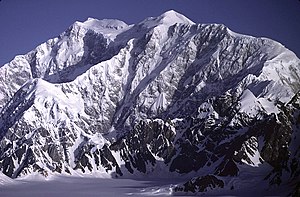
This article comprises three sortable tables of major mountain peaks[1] of Canada.
The summit of a mountain or hill may be measured in three principal ways:
- The topographic elevation of a summit measures the height of the summit above a geodetic sea level.[2] The first table below ranks the 100 highest major summits of Canada by elevation.
- The topographic prominence of a summit is a measure of how high the summit rises above its surroundings.[2][3] The second table below ranks the 50 most prominent summits of Canada.
- The topographic isolation (or radius of dominance) of a summit measures how far the summit lies from its nearest point of equal elevation.[4] The third table below ranks the 50 most isolated major summits of Canada.
- ^ This article defines a significant summit as a summit with at least 100 metres (328.1 feet) of topographic prominence, and a major summit as a summit with at least 500 metres (1640 feet) of topographic prominence. All summits in this article have at least 500 metres of topographic prominence. An ultra-prominent summit is a summit with at least 1500 metres (4921 feet) of topographic prominence.
- ^ a b If the elevation or prominence of a summit is calculated as a range of values, the arithmetic mean is shown.
- ^ The topographic prominence of a summit is the topographic elevation difference between the summit and its highest or key col to a higher summit. The summit may be near its key col or quite far away. The key col for Denali in Alaska is the Isthmus of Rivas in Nicaragua, 7642 kilometres (4749 miles) away.
- ^ The topographic isolation of a summit is the great-circle distance to its nearest point of equal elevation.
© MMXXIII Rich X Search. We shall prevail. All rights reserved. Rich X Search
